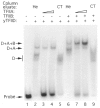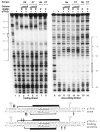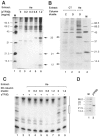Identification of three mammalian proteins that bind to the yeast TATA box protein TFIID
- PMID: 1633441
- PMCID: PMC6057387
Identification of three mammalian proteins that bind to the yeast TATA box protein TFIID
Abstract
The TATA box binding transcription factor TFIID of S. cerevisiae was used as a ligand for affinity chromatography. Polypeptides that bind specifically to yeast TFIID (TFIID-associated proteins, DAPs) were purified from human HeLa (heDAPs) and calf thymus (ctDAPs) whole cell extracts. Both heDAP and ctDAP fractions altered the binding of TFIID to the TATA element, and substituted for the TFIIA transcription activity in a reconstituted in vitro system. The heDAP fraction also behaved like TFIIA in its ability to form a promoter-TFIID-TFIIA complex and to recruit TFIIB to such a complex. The interaction of DAPs with TFIID can confer heat-resistance (47 degrees C) on recombinant yeast or human TFIID. SDS-PAGE analysis revealed that three polypeptides from HeLa extracts specifically bound to yTFIID columns (heDAP35, heDAP21, and heDAP12). These data suggest that a multi-subunit transcription factor with the properties of TFIIA can bind to TFIID in the absence of DNA.
Figures






Similar articles
-
Affinity purification of transcription factor IIA from HeLa cell nuclear extracts.EMBO J. 1991 Aug;10(8):2305-10. doi: 10.1002/j.1460-2075.1991.tb07767.x. EMBO J. 1991. PMID: 2065666 Free PMC article.
-
Factors involved in specific transcription by mammalian RNA polymerase II: purification and analysis of transcription factor IIA and identification of transcription factor IIJ.Mol Cell Biol. 1992 Jan;12(1):413-21. doi: 10.1128/mcb.12.1.413-421.1992. Mol Cell Biol. 1992. PMID: 1729613 Free PMC article.
-
Molecular cloning of the small (gamma) subunit of human TFIIA reveals functions critical for activated transcription.Genes Dev. 1994 Oct 1;8(19):2324-35. doi: 10.1101/gad.8.19.2324. Genes Dev. 1994. PMID: 7958899
-
Purification, assay, and properties of RNA polymerase I and class I-specific transcription factors in mouse.Methods Enzymol. 1996;273:233-48. doi: 10.1016/s0076-6879(96)73023-9. Methods Enzymol. 1996. PMID: 8791616 Review. No abstract available.
-
Mechanisms of transcriptional activation in vivo: two steps forward.Trends Genet. 1996 Aug;12(8):311-5. doi: 10.1016/0168-9525(96)10028-7. Trends Genet. 1996. PMID: 8783941 Review.
Cited by
-
Separation of the transcriptional coactivator and antirepression functions of transcription factor IIA.Proc Natl Acad Sci U S A. 1996 Jun 25;93(13):6583-8. doi: 10.1073/pnas.93.13.6583. Proc Natl Acad Sci U S A. 1996. PMID: 8692860 Free PMC article.
-
Interactions of a DNA-bound transcriptional activator with the TBP-TFIIA-TFIIB-promoter quaternary complex.J Biol Chem. 2003 Mar 28;278(13):11495-501. doi: 10.1074/jbc.M211938200. Epub 2003 Jan 21. J Biol Chem. 2003. PMID: 12538582 Free PMC article.
-
Binding of basal transcription factor TFIIH to the acidic activation domains of VP16 and p53.Mol Cell Biol. 1994 Oct;14(10):7013-24. doi: 10.1128/mcb.14.10.7013-7024.1994. Mol Cell Biol. 1994. PMID: 7935417 Free PMC article.
-
A TATA sequence-dependent transcriptional repressor activity associated with mammalian transcription factor IIA.EMBO J. 1994 Jan 15;13(2):435-45. doi: 10.1002/j.1460-2075.1994.tb06278.x. EMBO J. 1994. PMID: 8313889 Free PMC article.
-
Structural and functional interactions of transcription factor (TF) IIA with TFIIE and TFIIF in transcription initiation by RNA polymerase II.J Biol Chem. 2001 Oct 19;276(42):38652-7. doi: 10.1074/jbc.M106422200. Epub 2001 Aug 16. J Biol Chem. 2001. PMID: 11509574 Free PMC article.
References
Publication types
MeSH terms
Substances
LinkOut - more resources
Full Text Sources
Molecular Biology Databases
